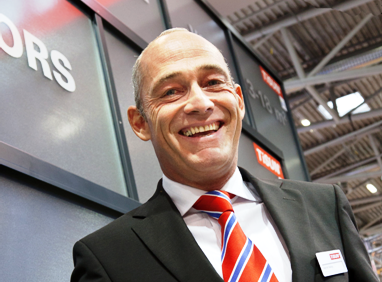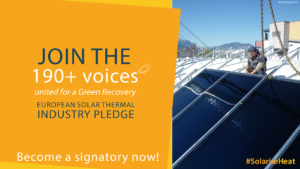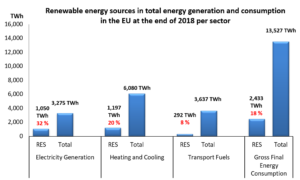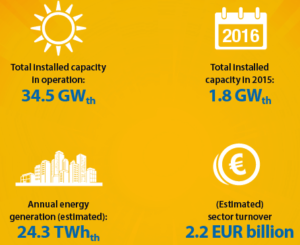ESTIF Rebranding: “We are solar, we are heat, we are Europe”
August 7, 2017
 The European Solar Thermal Industry Federation (ESTIF) has recently changed its name to Solar Heat Europe and developed a new corporate identity. It represents the interests of the solar thermal sector at EU institutions and is home to around 50 European solar thermal manufacturers, national industry associations, research institutes and service providers. Solar Heat Europe’s headquarters are in Brussels, where a team of four strives to advance solar heat solutions. Solarthermalworld.org spoke with President Robin Welling about the purpose of the rebranding effort. Welling is Managing Director of Austrian collector manufacturer and system supplier Tisun and has been President of ESTIF since 2010.
The European Solar Thermal Industry Federation (ESTIF) has recently changed its name to Solar Heat Europe and developed a new corporate identity. It represents the interests of the solar thermal sector at EU institutions and is home to around 50 European solar thermal manufacturers, national industry associations, research institutes and service providers. Solar Heat Europe’s headquarters are in Brussels, where a team of four strives to advance solar heat solutions. Solarthermalworld.org spoke with President Robin Welling about the purpose of the rebranding effort. Welling is Managing Director of Austrian collector manufacturer and system supplier Tisun and has been President of ESTIF since 2010.Source: Solar Heat Europe & Tisun
Solarthermalworld.org: Just recently, ESTIF has changed its name to Solar Heat Europe and created a new corporate identity. What has prompted this change?
Welling: Throughout its existence, ESTIF has brought together stakeholders from the solar thermal sector, has promoted their interests under one umbrella and has been a driving force behind the popularisation of solar heat in Europe. To facilitate industry representation and strengthen the market position and popularity of solar heating and cooling among members of European institutions, we intended to project a fresh and reinvigorated image. It was the primary motivation for kicking off a member debate about rebranding ESTIF. The outcome of this process is now there for all to see: Solar Heat Europe, launched this July.
This final solution will also help market participants and politicians to be more aware of the difference between solar thermal and PV. We wanted to make clear that solar thermal or solar heat has its own distinct identity. The name had to be more illustrative of our sector than an acronym such as ESTIF. It’s been a trend among other European trade association as well – including the renewable ones.
Solarthermalworld.org: Has this been only a communications issue or do you expect to see it attracting members from related industries?
Welling: Our primary motivation was the communicative aspect, which means there won’t be an impact on the structure or aims of our organisation. Having said this, the rebranding, including the new logo, does promote a reinvigorated, fresh image of our organisation and the entire sector. As we would say: “We are solar, we are heat, we are Europe.”
We also think that the new industry image will attract new members from the entire supply chain, be it storage manufacturers or system providers. We want to present a new and fresh image and continue to give a voice to Europe’s solar heat sector, particularly when dealing with European institutions. As such, the timing of the change is crucial, as we are at an important crossroads concerning the definition of main European policies affecting our sector over the next decade, between 2020 and 2030.
Solarthermalworld.org: Will you keep the focus on solar thermal only or does the change imply a greater scope from now on?
Welling: Our name change to Solar Heat Europe should not imply that we are only looking at solar heat options. We still keep our role in the industry as promoting solar heating and cooling and also renewable heat and cooling, in a broader context.
As the sector evolves, so will our membership structure. But it should be the result of being the industry’s voice in Europe, a meeting point for the sector’s main players, and a service provider to our members and the industry. Membership should evolve on that basis, rather than just being the result of a rebranding effort.
Solarthermalworld.org: Are you planning to strengthen the cooperation with other renewable heat associations?
Welling: We’ve already been cooperating with different entities to pursue our objectives, mainly at policy level, but also in other fields. And cooperation isn’t limited to renewable heat. We’ve been an active member of the Heat Coalition. This coalition played an important role in placing heating and cooling on the agenda of European politicians, later resulting in the European Heating and Cooling Strategy. More recently, we’ve also joined the coolingEU initiative. We have a long-standing collaboration with EHI, the Association of the European Heating Industry. Of course, we also work in partnership with other RES associations from the power and heat sector. Even if our main cooperative efforts are within the renewable heat sector, our work requires a much larger variety of partnerships.
“Beware of the risks from ‘wild electrification’”
Solarthermalworld.org: Are you satisfied with the EU’s current renewable heat policy?
Welling: We are not satisfied with it, but we are pleased with the evolution we have witnessed. As mentioned before, together with our partners, we’ve managed to put heating and cooling – particularly renewable heat – on the agenda.
The current Renewable Energy Directive has done little to address the heating and cooling sector. It has been a big boost to other renewable technologies, such as PV, but may have even been detrimental to solar thermal. We are not in line to meet the solar thermal targets defined in the national plans. But most countries will be able to meet their overall targets, primarily because of renewable electricity.
The EU Strategy for Heating and Cooling launched at the beginning of last year has been an important step forwards. This proposal by the European Commission has been central to helping member states explore the untapped potential of renewable heat.
We’ve also seen the European Commission trying to assume a more decisive role when it comes to promoting renewable heating and cooling. That was apparent by their Clean Energy Package proposals, namely for RED II, the new version of the Renewable Energy Directive, their suggestions to increase the share of renewable heating and cooling in final energy consumption by 1 % each year, their planning requirements for an assessment of national renewable or heating and cooling potential and their initiatives to help suppliers of renewables gain access to local district heating and cooling networks.
Solarthermalworld.org: What will be the most urgent actions to take and lobby for?
Welling: One of our main priorities this year will be to keep the aforementioned proposals in the final version of the directive, then to improve the text for wider impact. We are also pushing for other proposals, such as the labelling of old boilers or the inclusion of references to renewable heat in Energy Performance Certificates.
Overall, these are positive developments where ESTIF/Solar Heat Europe has played an important role together with other organisations. But our work is not done, as the negotiations on the Clean Energy Package are ongoing.
Additionally, we do see new challenges ahead, for example, regarding the electrification of heat, something that is being pushed by the power sector, including RES electricity, to be reflected in different elements of the Clean Energy Package. We have been very vocal here and have had some success warning of the risks from what we call the “wild electrification” of heat. It’s no easy task, though, when you face large lobbying organisations.
More information:
Geoffroy Cazenave,
Communications Officer at Solar Heat Europe:
+32 2 318 40 60
Solar Heat Europe: http://solarheateurope.eu


